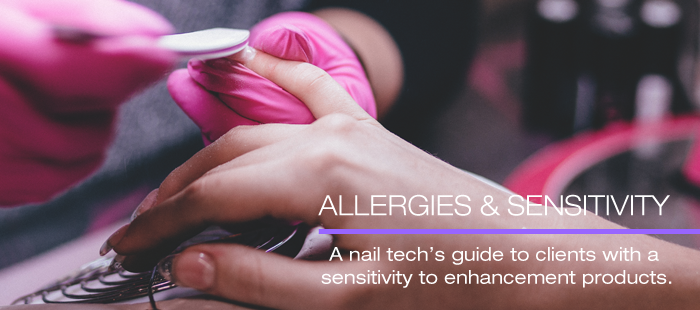July 26-31st || Spend $200 get a FREE Attraction Discover Kit || Exclusions apply SHOP NOW
Understanding Clients with Nail Enhancement Allergy & Sensitivity

As a nail technician, some clients may approach you with a reaction to nail enhancement products. If you are working with quality enhancement products such as NSI, this does not always mean the product you are working with is “bad”. This reaction can be caused by overexposure to the product, and can develop into an allergy – and this can be avoided.
OVEREXPOSURE:
Overexposure is caused from prolonged, repeated exposure to a chemical beyond the levels specified as safe by the manufacturer.
The most common sign of overexposure to chemicals is skin irritation, it is not an immediate sign that you are allergic to a chemical, it is a warning sign that if overexposure of the chemical continues, the person may become permanently sensitized or allergic to that chemical.
WAYS TO PREVENT OVEREXPOSURE:
- Avoid touching the clients skin with the brush.
- After placing the bead of acrylic, wipe any excess monomer from the brush before working with the bead.
- Work within the manufacturers recommended mix-ratio when using acrylic.
- Do not use acrylic monomer (liquid) without polymer (powder).
- Change the UV bulbs in your lamp every 4-6 months.
- Change table towels after each client.
- Recommend the client seek the advice of a pharmacist or dermatologist.
ALLERGIES WITH PRODUCT:
An allergic reaction to nail products are caused by prolonged and repeated direct contact by any product, not to the vapors. Most of these allergic reactions are caused by the HEMA in nail enhancement products. Although HEMA is mostly found in monomer, gels do contain small amounts of HEMA as well. NSI does have a HEMA-Free nail liquid, Universal Nail Liquid, for clients that experience sensitivity issues.
To Remove Enhancement Products:
Remove the product safely by soaking the nails in Soothing Soak Off Remover. An excellent way to remove acrylic is to saturate a cotton ball with Soothing Soak Off Remover and place on the nail, wrap the finger in aluminum foil and allow body heat to activate the removal.
When the reaction subsides, apply an enhancement service that is less likely to cause a reaction based on the Adverse Reaction Chart.
Adverse reaction chart
The Adverse Reaction Chart is the list of enhancement service types in order from which products cause the most adverse reactions to the products that cause the least reactions and why they are in this order. Using this list you can find the service that best suits your clients’ that may be experiencing skin irritation and allergic reactions.
Odor-Free Light Cured Liquid and Powder
Reason: There are a limited number of products technicians can use to keep products odor-free.
Light Cured Gels
Reason: NSI Gel Systems need a nail lamp to cure. If not fully cured, the chemicals could stay trapped in the enhancement. Manufacturers’ suggested cure times should always be followed. This will ensure that your gels are fully cured through.
Odor-Free Monomer
Reason: Spa Nail Liquid needs to be used dry to avoid unreacted monomer from absorbing down into the nail plate.
Acrylic Systems
Reason: Attraction Liquid has lower odor because of the slower evaporation rate.
HEMA-Free Monomer
Reason: Universal Liquid is basic monomer chemistry without the UV protection additives.
No Light Gels or Wraps
Reason: These products are typically not strong.
Nail Technicians and Allergic Reactions
A nail technician can also become allergic to enhancement products for the same reason a client can become allergic – overexposure. Nail technicians can develop allergies from different types of exposure to the product, and there are some simple guidelines to help prevent an allergy:
- Wash hands between each client with soap and water.
- Change table towels during acrylic service, after application and before finishing.
- Do not touch the brush hairs with your fingertips.
- Avoid resting your wrist or palm on a soiled table towel.
- Use a small, shallow Dappen Dish to avoid getting monomer on your brush handle.
- If necessary, use barrier cream or nitrile gloves.
- Remembering to always work in a clean environment will help reduce the risk of overexposures.
